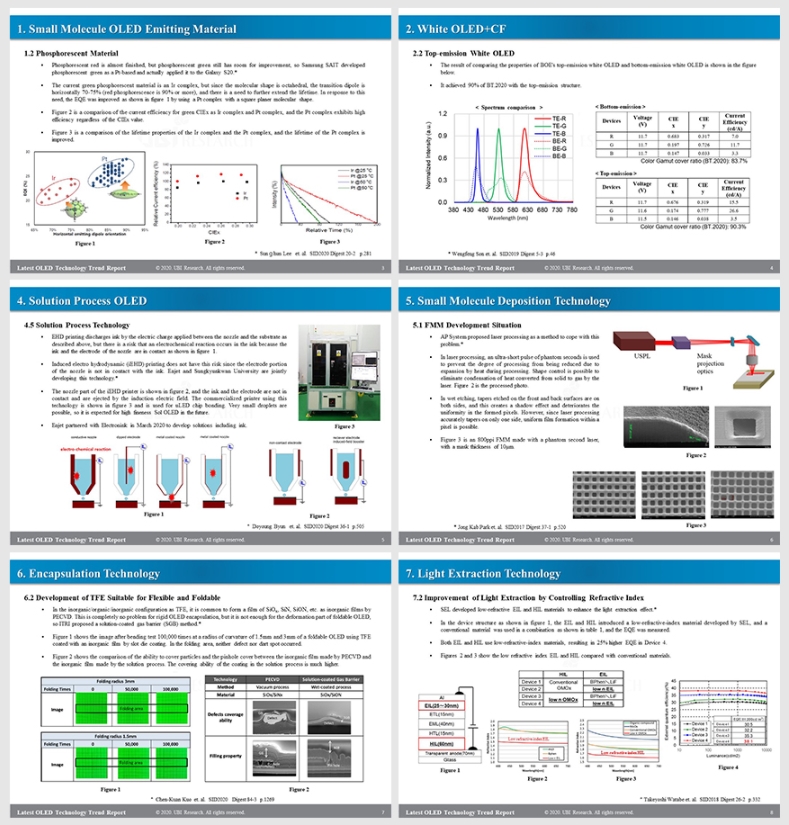Special Report
Latest OLED Technology Trend Report
₩3,500,000
September 15, 2020
PDF(133P)Introduce
The “Latest OLED Technology Trend Report” analyzed the research presented by display companies, research institutes, and universities in SID, IMID, IDW from 2016 to 2020, and carefully selected and organized only the technology used in OLED manufacturing and the technology deemed applicable in the future.
It was compiled by Urabe (former Sony OLED development team leader/development director), a senior analyst at UBI Research.
The report will be a guideline that shows OLED developers the goals and directions of development by technology.
Contents
1. Small Molecule OLED Emitting Material1.1 Fluorescent Material
1.2 Phosphorescent Material
1.3 TADF
1.4 Hyper-fluorescence
1.5 Proposal of Next-generation Emitting Materials
1.6 Total
2. White OLED+CF
2.1 Bottom-emission White OLED
2.2 Top-emission White OLED
2.3 Improvement of Properties of White OLED+CF Method
3. OLED Device Technology
3.1 Inverted OLED
3.2 Transparent OLED
3.3 Electrode Material
3.4 Polarizer
3.5 Color Viewing Angle Dependence Analysis
3.6 Wide Viewing Angle Technology (Moth-eye)
3.7 Transparent Cathode for Top-emission
3.8 Tandem Blue OLED for QD-OLED
3.9 Rollable OLED Display
4. Solution Process OLED
4.1 Current Situation and Problems of Sol OLED
4.2 Development Status of Material for Solution Process: Polymer System
4.3 Comparison between Polymer and Small Molecule Evaporation Materials
4.4 Polymer + Small Molecule Solution Process Materials Development Status
4.5 Solution Process Technology
4.6 Solution Process Device Technology
4.7 Sol OLED
5. Small Molecule Deposition Technology
5.1 FMM Development Situation
5.2 High-fineness Mask for Small Molecule Deposition
5.3 Effect of Deposition Conditions on The Film
5.4 Property Reproducibility
5.5 Patterning of Small Molecule Evaporated Films by Lithography
5.6 Small Molecule Deposition System
6. Encapsulation Technology
6.1 Development Status of Thin Film Encapsulation Technology
6.2 Development of TFE Suitable for Flexible and Foldable
6.3 Face seal
7. Light Extraction Technology
7.1 Improvement of Light Extraction by Molecular Orientation
7.2 Improvement of Light Extraction by Controlling Refractive Index
7.3 Improvement of Light Extraction by Removing Waveguide Mode
7.4 Improvement of Light Extraction by Structure Installation
8. Foldable Technology
8.1 Device Design for Foldable
8.2 Development for Neutral Plane Splitting
8.3 Foldable Material Development
Report Sample
Previous Report Status
Related Products
-

Latest Technology Development Trends for OLED and QD-LED
₩5,000,000August 29, 2021
PDF(187P)The “Latest Technology Development Trends for OLED and QD-LED” report published this time contains the latest technology trends that show the current state of evolving OLED and the future evolution direction.
In addition, the latest technological trends related to QD-LED, which is called next-generation display technology following OLED, are also included in this report. If the LED itself emits light, it will be a self-luminous device with a wide color gamut, and since the solution process is possible, the manufacturing cost can be reduced, so expectations are rising as a next-generation device. -

Small Sized AMOLED Manufacturing Process Report Ver. 6
₩4,000,000March 8, 2024
PDF(218P)The Small Sized AMOLED Manufacturing Process Report covers the manufacturing process for each type of TFT, including LTPS and LTPO TFT, as well as OLED structure and manufacturing process, inspection process, and module manufacturing process.
In this small sized AMOLED manufacturing process report, the Galaxy Z Fold5 structure and module process have been updated for the small OLED manufacturing process. In addition, the eLEAP process and SEL’s photolithography process, which are photolithography OLED processes that have attracted great attention as high-resolution microdisplay OLED manufacturing processes, have been newly added or updated.
This report is a must-read for display companies to understand the AMOLED manufacturing process from TFT substrate to module manufacturing. -

Middle and Large Sized AMOLED Manufacturing Process Report Ver. 6
₩4,000,000March 8, 2024
PDF(194P)This report covers the manufacturing process of each type of TFT, including LTPO and Oxide TFT, as well as the structure and cell manufacturing process of OLEDs.
The MLA (micro lens array) formation process for enhancing the brightness of WOLED TVs and the encapsulation process for QD-OLED TVs have been added to the medium and large AMOLED manufacturing process report. Also newly added or updated are the Oxide TFT process with a reduced number of masks, and the eLEAP process and SEL’s photolithography process, which are photolithography OLED processes that have recently attracted great attention as new 8th generation substrate OLED manufacturing processes.
This report will be a must-read for display companies to understand the AMOLED manufacturing process from TFT substrate to cell manufacturing.


